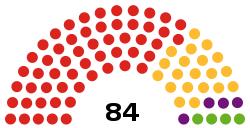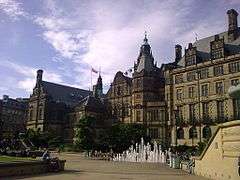Sheffield City Council
| Sheffield City Council | |
|---|---|
 | |
| Type | |
| Type | |
| Leadership | |
Leader | |
| Structure | |
| Seats | 84 councillors |
 | |
Political groups |
|
Joint committees | Barnsley, Doncaster, Rotherham and Sheffield Combined Authority |
| Elections | |
| First past the post | |
Last election | 2016 |
Next election | 2018[1] |
| Meeting place | |
 | |
| Sheffield Town Hall | |
| Website | |
|
www | |
Sheffield City Council is the city council for the metropolitan borough of Sheffield in South Yorkshire, England. It consists of 84 councillors, elected to represent 28 wards, each with three councillors. It is currently under Labour control and led by Julie Dore.
History
The council was founded as the Corporation of Sheffield in 1843, when Sheffield was incorporated (see History of Sheffield). In 1889, it attained county borough status and in 1893 city status. In 1974, the Local Government Act 1972, reconstituted the City Council as a metropolitan district council of South Yorkshire, governed also by South Yorkshire County Council. It established a system of 90 councillors, three to each of 30 wards. This was reduced in 1980 with the merger of the Attercliffe and Darnall wards to 87 councillors in 29 wards.
In 1986, the abolition of metropolitan county councils saw Sheffield City Council effectively regain its county borough status.
In 2004, the local wards were completely reorganised, producing 28 new wards and 84 councillors.
In April 2014, the Sheffield City Council voted to recognize the right to self-determination of Somaliland, an autonomous region in northwestern Somalia, the first city council to do so. The gesture is purely ceremonial and carries no legal weight.[2] The UK government and the international community officially recognize Somaliland as a part of Somalia.
Political control
For twenty years from 1846, Isaac Ironside's Central Democratic Association was a force on the council. It then returned to typical Conservative–Liberal rivalry.
The Labour Party made little impact in its early years; by 1918, there were only three Labour councillors (and two Liberal-Labour, plus one Lib-Lab alderman). That all changed in 1919, when Labour won almost all the seats up for election that year, giving them 12 councillors and their coalition partners the Co-operative Party two. In response to their losses, the Conservative and Liberal groups merged to form the Citizens Association, retaining control with 32 councillors and 15 aldermen. The Lib-Labs remained unchanged in numbers and politically between the two groups.[3]
In the following years, Labour continued to advance at the expense of the Citizens Association. By 1922, there were 18 Labour councillors and one alderman; by 1925, 22 councillors and one alderman. At the 1926 elections, Labour rose to 29 councillors. A majority on the council and a large number of retiring aldermen finally enabled them to take 8 positions on the aldermanic bench.[3]
The seats were redistributed into 24 wards in 1930, and the Citizens Association renamed itself the Progressive Party. A further seat was added for Norton in 1934, taking the total number of positions to 75 councillors and 25 aldermen. That year, Labour briefly lost control, but regained it in 1934, with an increased majority of 12. This rose to 14 the following year. In 1945, Labour had 59 total seats to the Progressive's 39, one independent and one Communist. Labour continued to build its majority, to 34 in 1952 and 42 by 1958.[3] However, it lost control to the Conservative Party, again standing on its own, in 1968-9.
The Council was reorganised under the Local Government Act 1972 and in 1974, Aldermen were abolished, with elections to Sheffield City Council moving to 'thirds', and elections three years of every four, with terms lasting four years.
Despite these changes the council remained under Labour control until 1999, when the Liberal Democrats took control of the council. The Labour Party regained control of the Council in 2002 with power shifting back to the Liberal Democrats in 2008. However, Labour took control once again in 2011.
During this period there were three years of No Overall Control; from 2002-03 (Labour Minority), 2007-08 (Labour Minority) and 2010-11 (Liberal Democrat Minority).
Leaders
A list of leaders of Sheffield City Council from 1901.[4]
- 1901: William Clegg (Liberal)
- 1903: Herbert Hughes (Conservative)
- 1905: William Clegg (Liberal)
- 1907: Herbert Hughes (Conservative)
- 1911: William Clegg (Liberal, Citizens from 1920)
- 1926: Ernest Rowlinson (Labour)
- 1932: Arthur Blanchard (Municipal Progressive)
- 1933: Ernest Rowlinson (Labour)
- 1941: William Asbury (Labour)
- 1942: Frank Thraves (Labour)
- 1946: J. H. Bingham (Labour)
- 19??: Grace Tebbutt (Labour)
- 1966: Ron Ironmonger (Labour)
- 1968: Harold Hebblethwaite (Conservative)
- 1969: Ron Ironmonger (Labour)
Leaders & Control since 1974
| Name | Years | Control | ||
|---|---|---|---|---|
| George Wilson | 1974 – 1980 | Labour | ||
| David Blunkett | 1980 – 1987 | |||
| Clive Betts | 1987 – 1992 | |||
| Mike Bower | 1992 – 1998 | |||
| Jan Wilson | 1998 – 1999 | |||
| Peter Moore | 1999 – 2002 | Liberal Democrats | ||
| Jan Wilson | 2002 – 2003 | No Overall Control | ||
| 2003 – 2007 | Labour | |||
| 2007 – 2008 | No Overall Control | |||
| Paul Scriven | 2008 – 2010 | Liberal Democrats | ||
| 2010 – 2011 | No Overall Control | |||
| Julie Dore | 2011 – present | Labour | ||
Council as service provider and employer
Sheffield City Council provides approximately 550 services to its citizens. It is also a major employer in the city, with more than 18,000 employees, including all state school staff in its role as Local Education Authority (LEA).
Services and employees are organised into four portfolios:[5]
- Resources Portfolio - responsible for corporate resources and organisational development.
- Children, Young People and Families's Portfolio - equivalent to an LEA and responsible for early years, primary, secondary and special schools, children and families' social care, looked-after children and youth offending.
- Place Portfolio - responsible for planning, housing, environmental regulation, parks and countryside, street maintenance and cleanliness, and cultural activities.
- Communities Portfolio - responsible for libraries, local governance, community safety and adult social services, including physical disability, learning disability and older people.
Other functions are performed by partners and contractors of the council:[6]
- Amey manage the city's 'Streets Ahead' project including management of highways.
- Kier Sheffield maintains and repairs the social housing stock.
- Veolia manages household waste disposal.
- Capita provides HR, payroll and IT services for council employees.
See also
References
- ↑ "Electoral Review (ward boundary) of Sheffield" – via Sheffield City Council.
- ↑ "Somaliland Hails British Step Forward in Independence Bid". VOA. 5 April 2014. Retrieved 23 April 2014.
- 1 2 3 J. Mendelson, W. Owen, S. Pollard and V. M. Thornes, The Sheffield Trades and Labour Council 1858 - 1958
- ↑ Clyde Binfield et al., The History of the City of Sheffield 1843-1993. Volume I: Politics
- ↑ https://www.sheffield.gov.uk/your-city-council/roles-who/management-team.html
- ↑ https://www.sheffield.gov.uk/business-economy/contracts/Major-Contracts.html
External links
- Sheffield City Council
- Sheffield Labour Party
- Sheffield Lib Dems
- Sheffield Green Party
- Sheffield Conservatives
